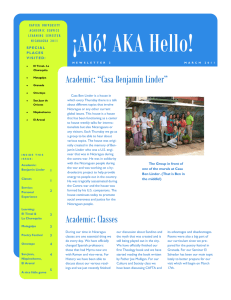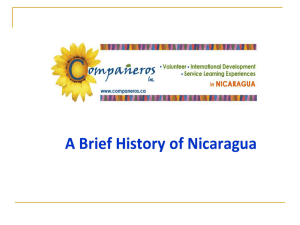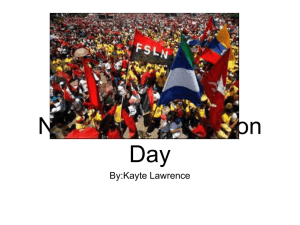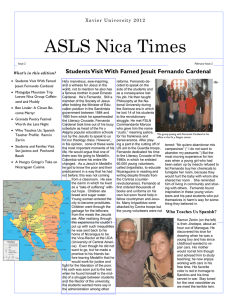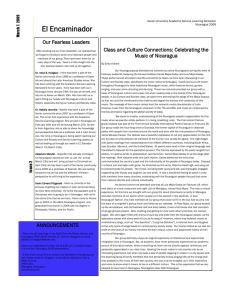XAVIER UNIVERSITYNICARAGUA ASLS 2010
advertisement
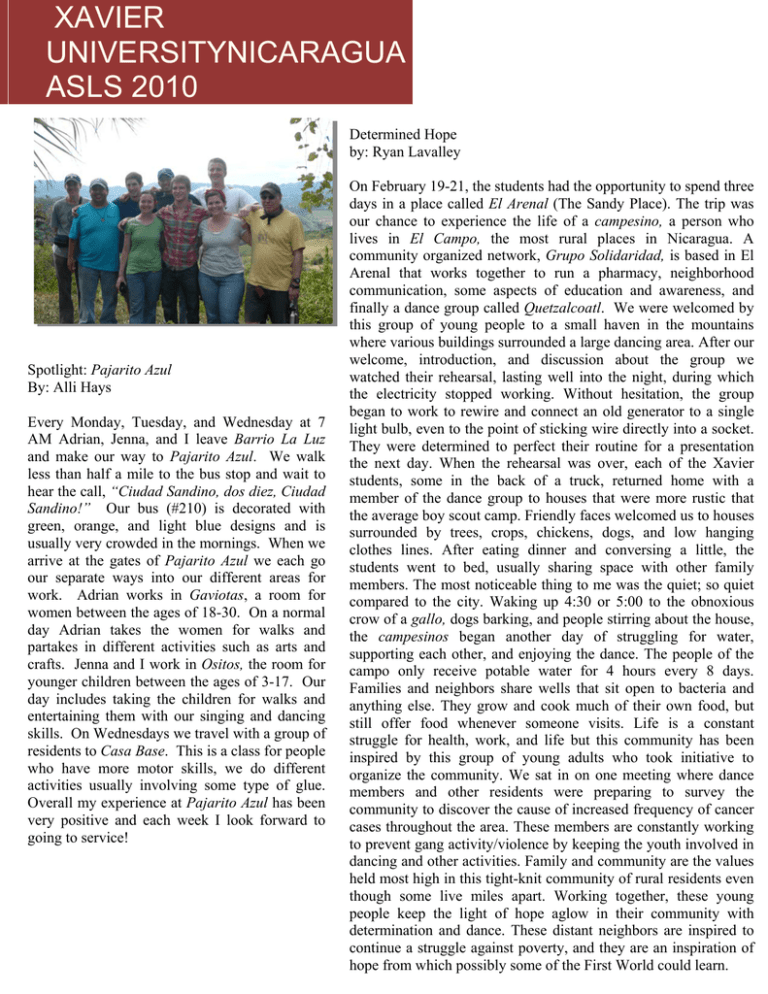
XAVIER UNIVERSITYNICARAGUA ASLS 2010 Determined Hope by: Ryan Lavalley Spotlight: Pajarito Azul By: Alli Hays Every Monday, Tuesday, and Wednesday at 7 AM Adrian, Jenna, and I leave Barrio La Luz and make our way to Pajarito Azul. We walk less than half a mile to the bus stop and wait to hear the call, “Ciudad Sandino, dos diez, Ciudad Sandino!” Our bus (#210) is decorated with green, orange, and light blue designs and is usually very crowded in the mornings. When we arrive at the gates of Pajarito Azul we each go our separate ways into our different areas for work. Adrian works in Gaviotas, a room for women between the ages of 18-30. On a normal day Adrian takes the women for walks and partakes in different activities such as arts and crafts. Jenna and I work in Ositos, the room for younger children between the ages of 3-17. Our day includes taking the children for walks and entertaining them with our singing and dancing skills. On Wednesdays we travel with a group of residents to Casa Base. This is a class for people who have more motor skills, we do different activities usually involving some type of glue. Overall my experience at Pajarito Azul has been very positive and each week I look forward to going to service! On February 19-21, the students had the opportunity to spend three days in a place called El Arenal (The Sandy Place). The trip was our chance to experience the life of a campesino, a person who lives in El Campo, the most rural places in Nicaragua. A community organized network, Grupo Solidaridad, is based in El Arenal that works together to run a pharmacy, neighborhood communication, some aspects of education and awareness, and finally a dance group called Quetzalcoatl. We were welcomed by this group of young people to a small haven in the mountains where various buildings surrounded a large dancing area. After our welcome, introduction, and discussion about the group we watched their rehearsal, lasting well into the night, during which the electricity stopped working. Without hesitation, the group began to work to rewire and connect an old generator to a single light bulb, even to the point of sticking wire directly into a socket. They were determined to perfect their routine for a presentation the next day. When the rehearsal was over, each of the Xavier students, some in the back of a truck, returned home with a member of the dance group to houses that were more rustic that the average boy scout camp. Friendly faces welcomed us to houses surrounded by trees, crops, chickens, dogs, and low hanging clothes lines. After eating dinner and conversing a little, the students went to bed, usually sharing space with other family members. The most noticeable thing to me was the quiet; so quiet compared to the city. Waking up 4:30 or 5:00 to the obnoxious crow of a gallo, dogs barking, and people stirring about the house, the campesinos began another day of struggling for water, supporting each other, and enjoying the dance. The people of the campo only receive potable water for 4 hours every 8 days. Families and neighbors share wells that sit open to bacteria and anything else. They grow and cook much of their own food, but still offer food whenever someone visits. Life is a constant struggle for health, work, and life but this community has been inspired by this group of young adults who took initiative to organize the community. We sat in on one meeting where dance members and other residents were preparing to survey the community to discover the cause of increased frequency of cancer cases throughout the area. These members are constantly working to prevent gang activity/violence by keeping the youth involved in dancing and other activities. Family and community are the values held most high in this tight-knit community of rural residents even though some live miles apart. Working together, these young people keep the light of hope aglow in their community with determination and dance. These distant neighbors are inspired to continue a struggle against poverty, and they are an inspiration of hope from which possibly some of the First World could learn. XAVIER UNIVERSITY NICARAGUA ASLS 2010 SECOND NEWSLETTER Mexican American in Nicaragua by Adrian González I am a proud Mexican American. I was born and raised on the Southside of Chicago in Pilsen, the second largest community of Latinos which is comprised mostly of Mexican immigrants or first generation Mexican Americans like me. In coming to Nicaragua I knew that my experience would be different from that of many students that had done this program in the past because I was not coming into a world that was completely unknown to me. I have no problems communicating with people because I am fluent in Spanish, and because of the color of my skin I blend in; in fact, most people think I am Nica until they hear my Mexican accent. For me this journey has been one of reconciliation between my own background and the country and people around me. What I have found is that we are more alike than I first thought, so much so that I feel I can call this home and not be lying. Despite the distance between my mother-land and Nicaragua, our cultures overlap and not just in language. The people look alike, not to say that in other countries people do not also look alike but ours do almost to a T. The music here, while they have their own artists and style are heavily influenced by artists and music from Mexico. I didn’t think that I would see mariachis--Mexico is known for them--but we found a plaza where they are all standing outside waiting for someone to come up to them and hire them. And what I found that was most important, at least to me, that overlapped, was the love of the Virgen de Guadalupe, the patron saint of Mexico. While entering a church in Niquinohomo, I found her image on the wall, I asked our guide why she was there. He told me that the Nica people love her because she looks like them; it makes them feel like she is their connection to God. I can easily say that was the best answer I had ever heard. All of those things make us similar and I have found that has made the transition here, at least for me, easier. Even our ancestry has a story of finding a new home with a sign from the gods: the island of Ometepe has a city, which like Mexico City, was originally founded by a sign from the Aztec gods. Two worlds apart in distance but close together in my heart, they are like two sisters independent and free but tied to one another. LEARNING THE CULTURE OF NICARAGUA THROUGH FOLKLORE DANCING CLASSES BY: PAT CONVEY In addition to all the new and exciting things that we have experienced since arriving in Nicaragua, we are still taking classes. But even these classes have a different experience than at Xavier. Our classes are in the houses of families throughout the neighborhood (barrio) and all of them focus on a different aspect of Nicaragua. With a lot of our classes we meet at least once a week and have homework, but the majority of our learning comes from investigating these aspects through talking with our families and attending talks about different issues. We then compare our experiences with different articles that we have read. In this way our educational experience is greatly enriched by studying academic theory and then examining the similarities and differences between these theories and our real life experiences. OUR FAMILY NEWSLETTER SECOND NEWSLETTER Kicking It with Fernando Cardenal by: John Herrick A few weeks ago, we seized the rare opportunity to meet with Father Fernando Cardenal, a Nicaraguan Jesuit priest who participated in the struggle against the Somoza dictatorship in the 70s, worked in the Sandinista government of the 80s as coordinator of the momentous National Literacy Campaign, and who currently directs the network of Fe y Alegria schools in Nicaragua, which provide education for the poor. Though a man of weighty accomplishment, Fernando was thoroughly welcoming, personable, and gracious in meeting with our group. He began by asking about us, and after learning who we are and why we are here in Managua, he told us this was a fantastic experience we were having in Nicaragua, and that he had experienced something like it. In the course of his education as a Jesuit Fernando spent time in Medellin, Colombia, living in an area with no electricity, no health care, no education--with only poverty. Every day in Medellin he witnessed people he had come to care for suffer deeply due to their hard, hopeless circumstances. He saw the children of a family he had grown close to eating from the garbage the Jesuits had thrown out. A young woman, the sole breadwinner for her family and a good friend of his, confided to him that she wanted to kill herself. With daily experiences of such bleak suffering, Fernando couldn’t accept that people lived this way. He decided that the poverty of Latin America had to change. In Medellin, he made a solemn promise “out of love for the people” to liberate the poor and to fight for justice. Since that day, Fernando has been living up to the promise he made to God and to the poor of Medellin. His high-stakes work in the struggle against the dictator Somoza, his leadership of the massive literacy campaign that required building a program from scratch that would teach the people to read and write in the face of violent resistance from the U.S-andHonduran-backed Contra Revolutionaries, and his continued life of work for and with the poor all are founded in Fernando’s foundational experience in Medellin of what it means to love and to be a Christian in a world with vast and miserable poverty. Flor De Caña by: John Fisk On Thursday February 18h, students traveled to an area of what was thought to be extreme poverty, but turned out to be the living space of ex- Flor de Cana workers. Flor de Cana (a famous rum that comes from sugar cane), has been using pesticides on their sugar cane field for approximately 50 years. Many of the workers have inhaled these pesticides and are now suffering from chronic renal failure. The workers are in this area to protest Flor de Cana’s lack of compensation for their illness. Xavier students got to visit and speak with many of the people who were camping out and were also suffering from this disease. They wanted us to know they are not protesting Flor de Cana’s rum, only the fact that the company is not paying adequate compensation to their workers. I had my own personal experience because I got to go into the tents of a man who was ill and I spoke with him for a while about his troubles. You can never really understand a problem like this until you see the people that it has affected. It certainly was an experience for all of us that I know I will remember. OUR FAMILY NEWSLETTER SECOND NEWSLETTER Matagalpa by: Jenna Hippensteel We spent February 13th and 14th in Matagalpa. We welcomed the brief reprieve from Managua’s heat (Matagalpa is farther north from Managua). It was far from chilly, although I did actually wear a jacket at night. The rest of the group ridiculed me for it. At any rate, we visited the Park of Stars, a handicapped accessible park that also offers therapy for people with disabilities. The organization that created the park also has a store that sells all-natural yogurt and cheeses; the store hires people with disabilities to continue the park’s mission of accessibility to all parts of life for everyone. After we went to Fetsalud, the union headquarters for public health care workers. It was very interesting, and we learned a lot about the history of union workers in Nicaragua and how Fetasalud is trying to improve health care today. We spent the night in an inn for pregnant women; a month before their due dates, women from the mountains come to the inn so that they will have access to an ambulance and a hospital when their babies arrive. On Sunday (fun fact: February 14th is celebrated in Nicaragua as the Day of Love and Friendship), we visited two coffee farms… Matagalpa is known for its coffee production. One was a family farm where we learned the process of coffee making. The second was a larger farm that produced more than coffee. We all learned how to milk a cow (except Pat…he doesn’t like livestock). That concluded our trip and subsequently concludes the article. For more information about Academic Service Learning Semesters or responses to this newsletter, contact Dr. Irene B. Hodgson, Director of the Xavier University Academic Service Learning Semesters at hodgson@xavier.edu or call 513-745-3541.
